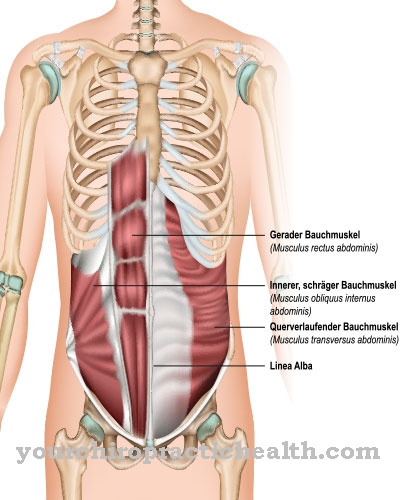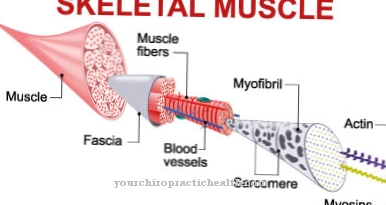The Majewski syndrome belongs to the group of osteochondrodysplasias, which are congenital. The disease thus has a genetic component. The Majewski syndrome is not to be confused with the so-called Lenz-Majewski syndrome. The disease is present from birth and is usually fatal for the affected patient. The main symptoms are underdevelopment of the lungs and shortening of the ribs.
What is Majewski Syndrome?

© BillionPhotos.com - stock.adobe.com
The Majewski syndrome was first described in 1971 by a doctor and researcher from Germany, Doctor Majewski. In honor of the first person to describe it, the disease was named Majewski's syndrome. In English, the disease is referred to in the majority of cases as Majewski's short rib syndrome designated.
It is particularly important to ensure that Majewski syndrome is not confused with the so-called Lenz-Majewski syndrome. Due to the similar names of the diseases, confusion in the colloquial area can occur. However, there are two different clinical pictures.The Majewski syndrome is an osteochondrodysplasia.
The Lenz-Majewski syndrome is synonymous with hyperostotic short stature Lenz-Majewski type. However, for Majewski syndrome there is no reliable information with regard to the frequency of occurrence of the disease. This may be due to the fact that the disease was described for the first time only a few decades ago and Majewski's syndrome is probably generally rather rare. It is now known that Majewski syndrome is inherited in an autosomal recessive way.
causes
The causes that lead to the development of Majewski's syndrome are still largely unexplained at the present time. Reasons for the lack of research studies may be that the disease is not particularly common and that it was not first described long ago.
So far it has been found that Majewski syndrome is a congenital disease. For this reason, it can be assumed that genetic defects, for example, are involved in the development of the disease. Mutations in the corresponding genes that lead to malformations in the body are conceivable.
Symptoms, ailments & signs
The Majewski syndrome causes several characteristic complaints and typical symptoms in the affected patients. The signs of the disease are usually very similar in different people. There are hardly any major differences in the individual characteristics of the malformations, since Majewski syndrome is relatively clearly differentiated from related syndromes.
One of the main symptoms of Majewski syndrome is an underdeveloped lungs. As a result, the oxygenation of the blood is impaired. As a result, the entire affected organism is not supplied with a sufficient amount of oxygen.
The symptom of underdeveloped lungs is also referred to in medical terminology as hypoplasia of the lungs. As a result, people suffering from Majewski's syndrome suffer from respiratory insufficiency. In addition, the patients suffer from shortened rib bones. This results in bad posture and other complaints.
Diagnosis & course of disease
The diagnosis of Majewski's syndrome is possible with the help of various examination-technical measures and procedures. If a person shows signs of the disease, these must be examined immediately by a suitable doctor. Usually, the main symptoms show up shortly after the affected person is born.
The malformations of the ribs are usually visible. The underdevelopment of the lungs also causes complications, so that they usually do not go undetected for long. For this reason, appropriate investigation measures are ordered quickly in most cases.
At the beginning there is a standard taking an anamnesis or a patient interview. Since the patients are often newborn infants, the anamnesis is taken together with the guardian. A thorough family history is particularly important because Majewski syndrome is a congenital disease.
It can therefore be assumed that the disease occurs more often in families. X-ray examinations, for example, are suitable for diagnosing Majewski's syndrome. As part of this imaging procedure, the shortened ribs are relatively clearly visible.
The underdeveloped lungs are also diagnosed using imaging, for example. In addition, it should be noted that the Majewski syndrome can already be detected in the embryo in the mother's abdomen with the help of sonographic procedures.
Complications
With Lenz-Majewski syndrome, those affected primarily suffer from short stature. In children, this complaint can lead to mental health problems or bullying and teasing. The quality of life of the person affected is considerably reduced by this disease. Furthermore, it is not uncommon for tooth decay and other defects to occur.
Without treatment, those affected suffer from severe toothache and other unpleasant symptoms in the oral cavity. It is not uncommon for Lenz-Majewski syndrome to lead to mental retardation, so that the patients are dependent on the help of other people in their everyday lives. Often the parents and relatives of those affected also suffer from the symptoms of psychological complaints or depression.
Furthermore, individual extremities can be shortened as a result of the disease, which can also lead to various restrictions in life. It is not possible to treat Lenz-Majewski syndrome causally. For this reason, treatment is primarily aimed at reducing the individual symptoms.
There are no complications, but the course of the disease is not completely positive. As a rule, those affected by Lenz-Majewski syndrome are dependent on the help of other people for their entire life.
When should you go to the doctor?
In most cases, patients with Majewski's syndrome show malformations of the bone structure immediately after birth. In the case of an inpatient delivery, the nurses, nurses or doctors do the first check-ups on the baby. You will determine the irregularities in a routine process and independently initiate the necessary medical care. In the case of a home birth or a birth in a birthing center, the midwives present take the first steps to check the child's health. If you discover abnormalities or perceive the visual changes in the newborn, you should also contact a doctor without delay.
There is therefore no need for the parents of the child to act in the cases mentioned. If a spontaneous birth occurs without the presence of an obstetrician, the mother and child should be transported to the nearest hospital immediately after the birth. If malformations are noticed or if the infant is noticed with a poor posture at this point in time, it needs an immediate medical examination. In the event of breathlessness or failure of the child to breathe, the emergency services must be alerted. In addition, first aid measures must be initiated to ensure the survival of the child. Without adequate oxygen supply, immediate death occurs.
Treatment & Therapy
According to the current state of medicine, the options for treating Majewski's syndrome are still relatively limited. In principle, therapy for the causes of the disease is not possible because it is a congenital disease. However, numerous research studies are working to advance genetic approaches to therapy.
For this reason, only symptomatic methods of treating Majewski's syndrome are currently available. For example, it is possible to correct the deformities as part of surgical interventions. However, due to the underdevelopment of the lungs, the prognosis for Majewski's syndrome is relatively poor.
Because the organism of the sick patient is not supplied with enough oxygen. In most cases, this does not develop into a problem until after the birth, as the embryo in the womb is supplied with oxygen by the mother. In newborns, complications arise relatively quickly due to an insufficient supply of oxygen. The Majewski syndrome is fatal in numerous cases because the affected people are not viable.
You can find your medication here
➔ Medicines for painOutlook & forecast
The prognosis for Majewski's syndrome is poor. This syndrome is based on a genetic defect that cannot be cured. For legal reasons, genetic changes in humans are not allowed. Therefore, doctors and medical professionals use symptomatic treatment methods. Nevertheless, the quality of life of the person affected is very limited. The organism is insufficiently supplied with vital oxygen. Many patients die prematurely within the first months of life shortly after birth.
The prognosis depends on the severity of the disorder. Although it is a genetic defect, it is developed differently in each affected person. The symptoms of the congenital disorder can be relieved by surgery in some patients. This depends on the overall situation and the health of the person concerned. In addition, the operations are associated with risks. Complications may arise that lead to further deterioration in health.
In the event of an unfavorable course of the disease, the underdevelopment of the lungs is corrected by a transplant in the surgical procedure. Nevertheless, the patient is dependent on drug treatment for life. Rejection reactions of the organism and thus a life-threatening condition can occur at any time.
prevention
Majewski's syndrome is a congenital disease that, despite advancing possibilities, cannot yet be prevented.
Aftercare
Since the treatment of Majewski syndrome is relatively complex and has to be lifelong, there is no follow-up care in the real sense. However, those affected can endeavor to find a good way of dealing with the disease and to build up a positive attitude despite the adversity. Relaxation exercises and meditation can help calm and focus the mind. Majewski syndrome is associated with a number of different complications and symptoms, all of which can usually have a very negative effect on everyday life and also on the person's quality of life. Since it is also a genetic disease, it cannot be completely cured, so that the person affected is dependent on lifelong therapy.
The various malformations can have a negative effect on the aesthetics of the person affected. If depressive traits and psychological moods emerge, this should be clarified with a psychologist. Occasionally, accompanying therapy can help to cope with the circumstances more easily and to better accept the illness.
You can do that yourself
Majewsk syndrome cannot yet be treated effectively. The most important measure is to relieve the symptoms and discomfort and to relieve the affected child of any pain. Since the disease is usually fatal, the parents concerned should seek psychological support as early as possible. The doctor will refer the child's parents to a professional if the diagnosis is appropriate.
If the outcome is positive, the child will need lifelong support. This is associated with considerable stress for the parents and cannot be managed in the long term without the help of an outpatient care service. Help should be sought early to avoid developing major psychological complaints.
If the Majewksi syndrome takes a negative course, it can be useful to visit a self-help group. In any case, the parents needed support in coping with grief and should speak to a psychologist for this. Relatives and friends are also an important support in the early days. The treatment of the disease cannot be supported by the parents, as intensive medical supervision of the child is always indicated.
























.jpg)



